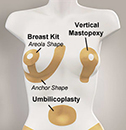Often times in plastic surgery there is no single best treatment option to achieve the outcome you desire. There may be several routes to get to a similar result with each choice entailing different degrees of risk and downtime. In the past, patients usually relied on the doctor to recommend their preference and that would be accepted without further inquiry. The advent of the internet with its easily accessible information and opinions combined with a move towards greater patient autonomy has changed the role of the patient from that of passive recipient of services to active participant in the decision making and treatment process.

Shared decision making has been adopted as an alternative to the standard approach to informed consent in hospital settings and with the treatment of medical conditions. It is characterized by a cooperative integration of the medical knowledge of the physician with the values and preferences of the patient. This approach avoids the problems of paternalism or coercion that can develop when input from the patient is not considered. Health policy makers also feel that utilizing more patient-centered concepts in clinical practice has the potential to improve the overall quality of care and lower costs through better utilization of services.
Tags: informed consent, Plastic Surgery, shared decision making
Written by Dr. Forley on January 28, 2014




